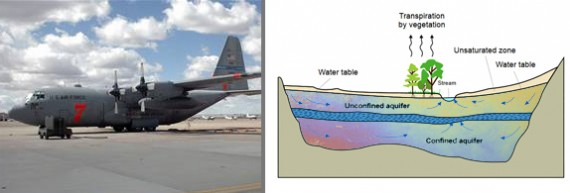Those of us involved in Kirtland spill activism have been hearing for a couple of months now that our spill has gotten the attention of Air Force leaders in Washington and that “big changes are coming.” In particular, the rather incendiary April 22 Citizen Advisory Board (CAB) meeting, which was partially aired on the PBS Newshour, apparently convinced the Air Force that change was needed. Therefore it was with great interest that I attended the July 22 CAB meeting and the “infofair” which preceded the meeting.
The infofair consisted of about 15 posters on various topics related to the spill arranged around the perimeter of a room in the Cesar Chavez Community Center. An equal or greater number of “experts” on the various topics were standing by the posters. I went over to look at a poster which diagrammed and explained the new “sentinel” monitoring wells which are scheduled to be installed near the threatened Ridgecrest drinking wells between now and the end of this year. Citizen Action NM (CANM) and the Water Authority Board (ABCWUA) have been demanding these wells for over 2 years, and they are vitally necessary to ensure that the toxic carcinogen ethylene dibromide (EDB) has not reached the drinking wells, so I was very interested in learning more about them. I had a very pleasant and informative conversation with Mr. Nathan Myers of the U.S. Geological Survey (USGS), who is in charge of this project. I learned that three sentinel wells are planned, each with four separate wells of varying depths, the deepest being 1400 feet.
After chatting with a few people that I knew at the infofair, I went into the CAB meeting. Col. Tony Haught, recently arrived from the Pentagon, amiably introduced the meeting and assured those present that the Kirtland spill was being given a higher priority by the Air Force. Then Wayne Bitner, Chief of Environmental Restoration at Kirtland, introduced Michael Amdurer, Project Manager with CB&I, the contractor hired by Kirtland to work on the spill. Mr. Amdurer made a Powerpoint presentation on a brief history of the spill and current state of the remediation efforts. He estimated the size of the spill as 6 million gallons, a figure that is dramatically different from the 24 million gallon estimate by NMED. It is not clear which estimate is closer to the actual amount, given the lack of precise characterization of the spill. Another source of confusion concerns the question of what percentage of the contamination is currently in the soil (vadose zone) and what percent is in the aquifer. At the April 22 CAB meeting, we were told by Col. Lanning that approximately 80% of the contamination was in the aquifer. However, at the July 22 meeting, Mr. Amdurer said that the 80% figure was wrong and that the majority of the contamination was “in the area of the spill.” No explanation or evidence was given to support this more optimistic scenario.
Mr. Amdurer also discussed the pilot air sparging/SVE project which is experimenting with removing contamination from the water, as well as in situ bioremediation experiments that are being tried. These efforts are controversial and whether or not they will be successful is not clear. He went on to briefly describe a “pump and treat” plan that is scheduled to be implemented by the end of 2014 and which will be designed to remove as much EDB as possible from the leading edge of the plume before it spreads further into the aquifer and the vicinity of the drinking wells. Heavily contaminated water from the plume will be pumped out, treated using activated carbon filtration, and then used for industrial or landscaping purposes (decisions have not yet been made about what to do with the treated water).
The most encouraging part of the meeting was the introduction of Dr. Adria Bodour, an environmental scientist with the Air Force Civil Engineering Center who has been brought in from San Antonio to oversee the remediation effort. Dr. Bodour, a native of Albuquerque, was a breath of fresh air. She was informed, experienced, and articulate. She cares about Albuquerque and exuded self confidence and competence. After her brief presentation, the man sitting next to me said with feeling “After 15 years the Air Force has finally brought in the A team!” It was also heartening to see a female expert brought into what is an overwhelmingly male-dominated group. The ambient sexism in the room seemed to subside a bit.
At the end of her brief presentation, Dr. Bodour warned that remediation will not be simple or quick. She compared the Kirtland spill to another toxic spill (with a different mix of contaminants) that she had worked on which took ten years to successfully clean up. We can only hope that we have that long before the EDB hits our drinking wells.
At this point, I feel cautiously optimistic about the changes that the Air Force is making. I give them credit for realizing that changes were needed and bringing in new and more experienced people. However, many problems remain. NMED gave Kirtland a June 30, 2014 deadline to begin removing EDB from the aquifer, a deadline that was not met. Mr. Bitner said that their scheduled plan for removing EDB (pump and treat, etc.) was sufficient to meet the deadline, but this was not the original intention of the order. The new plans for remediation appear to be on the right track, but we need to see some EDB removal before we begin to celebrate. To date, no EDB has been removed from our aquifer.
Moreover, as Dave McCoy of Citizen Action said during the Q&A, we have “staggering unknowns” here (see a fuller discussion here). We do not know the size, location, or speed of the toxic plume with any precision. There is confusion about how much EDB is in the soil as compared with how much is in the aquifer. There are several remediation measures that are being tried (air sparging/SVE, in situ bioremediation, pump and treat); these need to be comparatively evaluated by experienced experts so as to achieve the best possible remediation. I hope that Dr. Bodour’s new technical team is up to these tasks.
As with all CAB meetings, the presenters were weak when it came to answering questions from the audience. One good question about the quantity of EDB present in the spill was ungracefully dodged with no response. Another questioner asked whether there were monitoring wells near the Ridgecrest drinking wells. The response was “yes,” but it should have been “no” because the questioner was obviously asking about the sentinel wells, scheduled to be built near the Ridgecrest wells by the end of this year. The existing monitoring wells are not close to the drinking wells, which is why the sentinel wells are badly needed. Another question was asked by a homeowner from the neighborhood of the spill about disclosure statements required by mortgage lenders concerning “any hazardous materials on or in close proximity to the property.” When this question was not answered, it was asked again by someone else, at which point Wayne Bitner said that he would refer this question to his legal department.
Finally, a question was asked about whether Kirtland was going to honor the ABCWUA resolution that no EDB would be allowed into Albuquerque’s drinking wells. Mr. Bitner answered that Kirtland is only required to reduce the EDB level down to the maximum contamination level (MCL) set by the EPA, which is 50 parts per trillion. This level is problematic because there is evidence of surplus cancers at this level. The EPA goal for EDB exposure is zero because it is toxic at any level. However, it is clear that Kirtland plans to ignore the ABCWUA resolution and will be attempting only to reduce the EDB contamination down to the 50 ppt. level.
The good news from this meeting is that some positive changes are being implemented. Why are things changing? Citizen activism. Citizen Action NM has been calling for changes such as outside experts being brought in, sentinel wells near the Ridgecrest drinking wells, and tracer dye technology to calculate the velocity of the spreading plume (a technology now scheduled to be implemented soon) for years, and these efforts now appear to be bearing fruit. In addition, all of the people who attended the April 22 CAB meeting and spoke up forcefully helped to bring about the current positive changes. Now is not the time to relax, for there is substantial work that still needs to be done to protect our drinking water. The history of this spill clearly reveals that unless citizens are informed and involved, nothing happens.
To stay informed you can follow events on the Citizen Action webpage or the Kirtland webpage (which will hopefully be updated soon).




Responses to “Change is in the Air, but Contamination still in the Ground and Water”